Discover the beauty of the Appalachian skies with our ultimate guide to blue birds in West Virginia! This state, rich in natural beauty and diverse habitats feeding bluebirds, is a haven for birdwatchers and nature enthusiasts alike.
Our comprehensive photo guide will introduce you to the stunning variety of blue birds that call West Virginia home, providing detailed information and high-quality images to help you identify each species with ease.
So grab your field guide and binoculars, and let’s explore the blue-hued wonders of the West Virginia wilderness!
Blue Birds Found In West Virginia
The diverse geography of West Virginia provides a multitude of habitats for birds. Its extensive deciduous and mixed forests, numerous rivers, and elevation range attract a variety of bird species.
In particular, the presence of old growth forests, which are crucial nesting habitats for many birds, and the abundance of food in the form of insects, seeds, and berries, make West Virginia a vital stopover for migratory birds and a permanent home for others.
The diverse range of habitats – from lowland forests and wetlands to high mountainous regions – ensures a similarly diverse range of bird species, including a variety of blue birds.
Eastern Bluebird
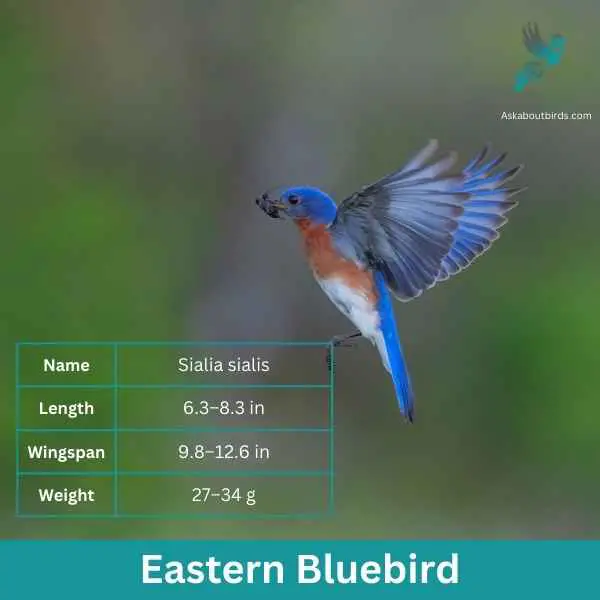
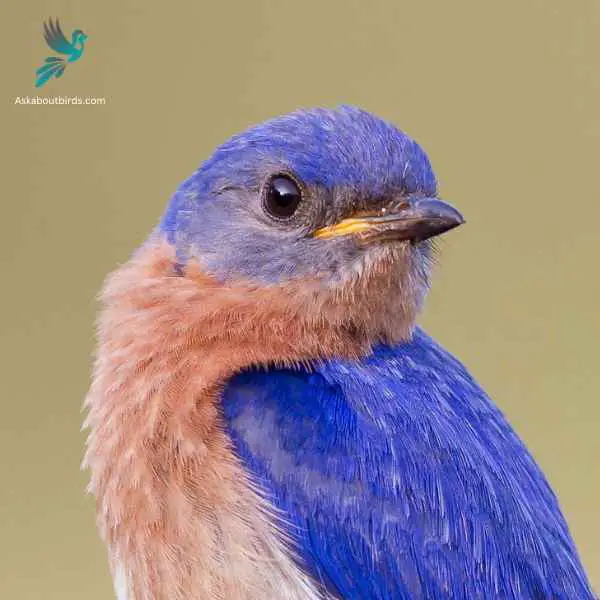
| Feature | Measurement |
|---|---|
| Scientific Name | Sialia sialis |
| Length | 6.3–8.3 in |
| Wingspan | 9.8–12.6 in |
| Weight | 27–34 g |
The Eastern Bluebird (Sialia sialis) is a small thrush found in open woodlands, farmlands, and orchards, and is recognized for its vibrant blue and red coloration. Male Eastern Bluebirds are dazzling with bright blue upperparts and a rusty or brick-red throat and breast, while females, though less colorful, still offer a similar pattern. The bird is native to North America and is commonly seen east of the Rockies, from Canada to the Gulf States and southeastern Arizona to Nicaragua.
Eastern Bluebirds feed on insects, wild fruit and berries. They have a gentle nature and are often seen perched alone or in small groups in the open, scanning the ground for prey. They are cavity nesters and will use old woodpecker holes or birdhouses if they are the right size.
Indigo Bunting


| Feature | Measurement |
|---|---|
| Scientific Name | Passerina cyanea |
| Length | 4.5–5.1 in |
| Wingspan | 7.1–9.1 in |
| Weight | 11.2–21.4 g |
The Indigo Bunting is a strikingly vibrant songbird, often hailed for its brilliant blue plumage and melodic song that graces woodlands and meadows during the warmer months.
Appearance: Males are renowned for their bright indigo blue feathers, which can appear darker in certain lights. Females and juveniles, on the other hand, are brown with subtle hints of blue on their wings and tail. The species lacks the vibrant streaking or spotting commonly found in many other songbirds.
Diet: Indigo Buntings primarily subsist on seeds, especially during non-breeding seasons. During the breeding season, they also consume a variety of insects such as beetles, caterpillars, and spiders, providing essential protein for their growing chicks.
Reproduction: Indigo Buntings build their nests close to the ground in shrubs or low tree branches. These nests, crafted meticulously with grasses and other plant materials, cradle clutches of typically 3 to 4 eggs. After hatching, the young are fed by both parents until they’re ready to fledge.
Blue Jay

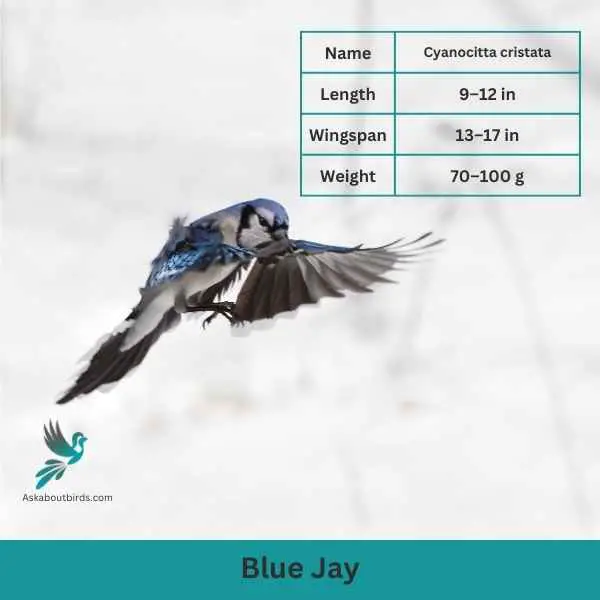
| Feature | Measurement |
|---|---|
| Scientific Name | Cyanocitta cristata |
| Length | 9–12 in |
| Wingspan | 13–17 in |
| Weight | 70–100 g |
The Blue Jay is a vibrant and easily recognized bird, known for its intelligence, distinctive calls, and bold behavior, commonly found throughout the eastern and central United States.
Appearance: The Blue Jay sports a striking blue upper body with white and black markings. Its face has a pronounced white patch with a black necklace that runs across the throat and around the head. The bird also features a pronounced blue crest, which can be raised or lowered, and its wings and tail are brightly colored with black bars and white tips.
Diet: Blue Jays are omnivores. Their diet consists primarily of seeds, nuts, especially acorns, fruits, and small insects. They’ve also been known to eat eggs or nestlings of other birds occasionally. Blue Jays often store food items in caches to eat later.
Reproduction: Blue Jays are monogamous birds that form long-lasting pair bonds. They typically build their nests in trees or large shrubs, constructing them from twigs, grass, and sometimes using mud as a binder. The female lays a clutch of 3 to 6 eggs, which are pale blue or sometimes white with brown speckles.
Tree Swallow
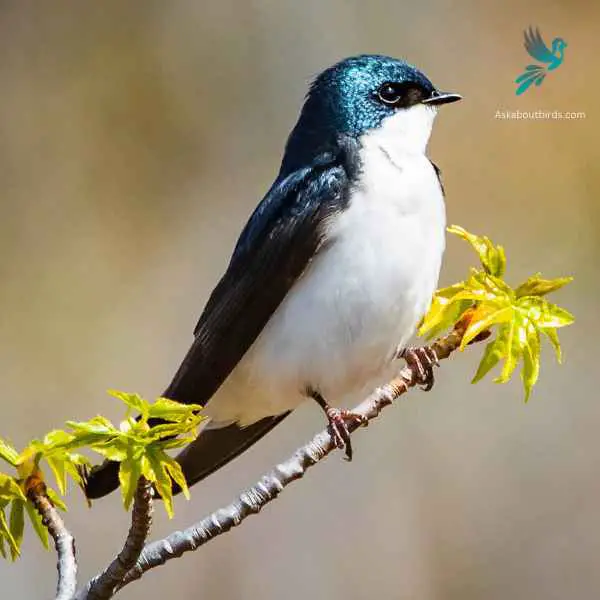
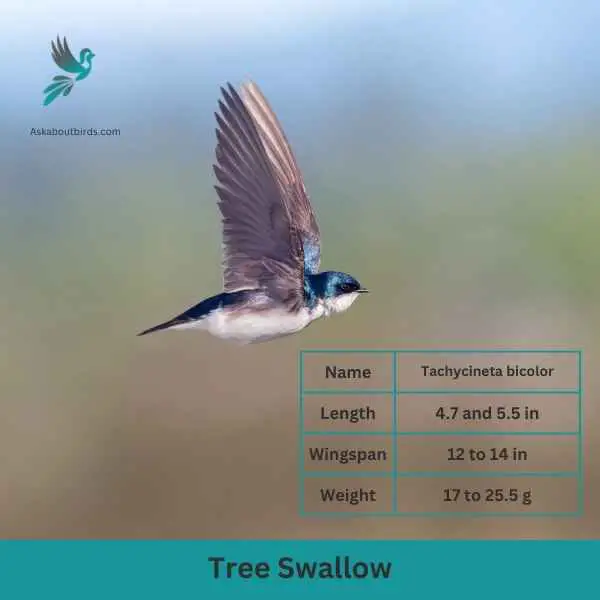
| Feature | Measurement |
|---|---|
| Scientific Name | Tachycineta bicolor |
| Length | 4.7 and 5.5 in |
| Wingspan | 12 to 14 in |
| Weight | 17 to 25.5 g |
The Tree Swallow is a graceful and agile bird, best recognized for its iridescent blue-green upperparts and sweeping flight patterns over open fields and water.
Appearance: The Tree Swallow is sleek with a streamlined body. The upperparts shine with a blue-green iridescence while the underparts are white. They possess long, pointed wings and a slightly forked tail, aiding in their agile flight.
Diet: Tree Swallows primarily feed on flying insects, skillfully catching them mid-air. During colder months when insects are scarce, they can switch to a diet of berries, particularly those of the bayberry, which other birds might find hard to digest.
Reproduction: Tree Swallows are cavity-nesters, typically choosing natural holes in trees or using bird boxes. They line their nests with feathers, creating a soft environment for the eggs. The female will lay a clutch of 4 to 7 white eggs.
Belted Kingfisher

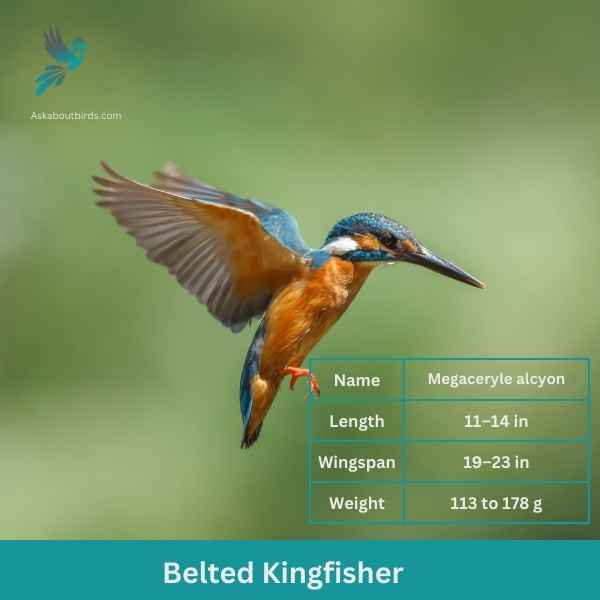
| Feature | Measurement |
|---|---|
| Scientific Name | Megaceryle alcyon |
| Length | 11–14 in |
| Wingspan | 19–23 in |
| Weight | 113 to 178 g |
The Belted Kingfisher is a distinctive and easily recognizable bird, frequently observed near water bodies, where it can be seen diving headfirst to catch prey.
Appearance: Sporting a prominent crest, the Belted Kingfisher has a slate blue-gray upper body and white underparts. Males possess a single blue band across their white chests, while females have an additional rufous band, making them one of the few bird species where females are more brightly colored than males. Their bill is long, sharp, and dagger-like.
Diet: As expert fishers, Belted Kingfishers mainly prey on small fish, but they’ll also consume crustaceans, insects, and amphibians. They’re known for their hunting tactic of hovering over water, spotting their prey, and then diving swiftly to snatch it.
Reproduction: Belted Kingfishers nest in burrows which they excavate in sandy or earthen banks, usually adjacent to water. The tunnel can be anywhere from 3 to 6 feet long, ending in a chamber. Within this chamber, the female lays a clutch of 5 to 8 white eggs.
Blue Grosbeak
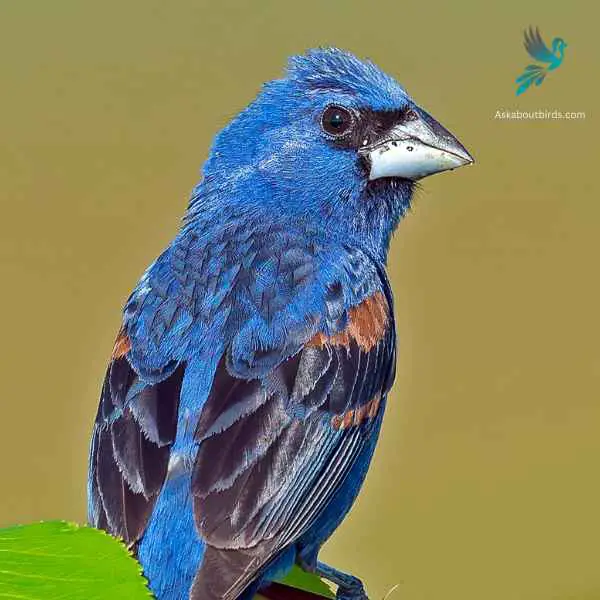

| Feature | Measurement |
|---|---|
| Scientific Name | Passerina caerulea |
| Length | 5.5 to 7.5 in |
| Wingspan | 10 to 11 in |
| Weight | 26 to 31.5 g |
The Blue Grosbeak is a medium-sized songbird found in North and Central America. The male Blue Grosbeak displays stunning plumage with deep blue feathers on its body and head, while the female has more subdued brownish tones. Both sexes have a thick, conical bill, which gives them their name “grosbeak,” meaning large beak.
These birds prefer open habitats such as grasslands, brushy areas, and woodland edges. Blue Grosbeaks are known for their melodious songs, which consist of a series of rich and varied notes. They primarily feed on seeds and insects, using their strong beaks to crack open seeds and forage on the ground or in low vegetation.
Barn Swallow


| Feature | Measurement |
|---|---|
| Scientific Name | Hirundo rustica |
| Length | 6.5–7.5 in |
| Wingspan | 12.5–13.5 in |
| Weight | 16–22 g |
The Barn Swallow is a sleek, agile bird renowned for its graceful flight patterns and iconic forked tail, often seen darting over fields and water bodies in search of flying insects.
Appearance: Barn Swallows have deep blue, almost iridescent, upperparts and a rufous to tawny underbelly. Their distinctively forked tail and long wings give them a streamlined look. Both males and females have a similar appearance, though males often exhibit slightly brighter colors and a deeper fork in the tail.
Diet: Barn Swallows feed primarily on flying insects, which they catch in mid-air during their agile and acrobatic flights. Their diet includes flies, beetles, moths, and other small flying insects.
Reproduction: Barn Swallows are known for building their mud nests on man-made structures, particularly barns, bridges, and eaves. The nest is cup-shaped and made from mud pellets, often lined with feathers. The female lays a clutch of 4 to 6 eggs.
Blue-headed Vireo
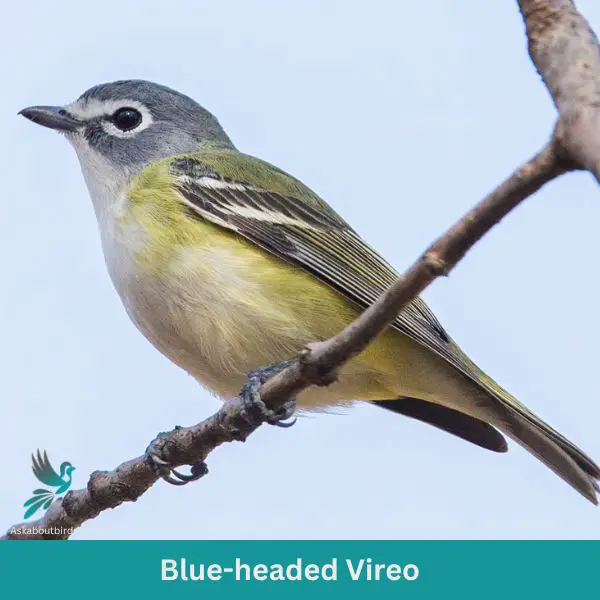
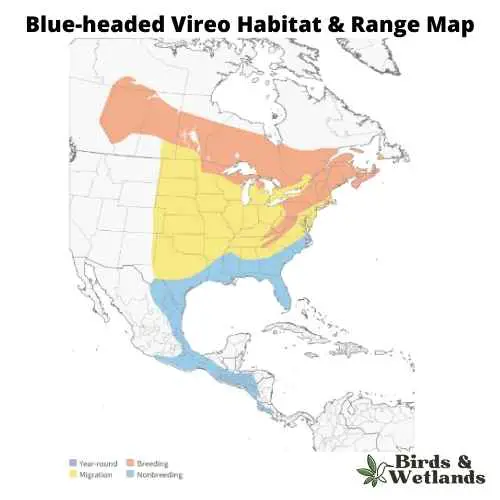
| Trait | Blue-headed Vireo |
|---|---|
| Scientific Name | Vireo solitarius |
| Length | 5-5.5 inches |
| Wingspan | 7.9-9.8 inches |
| Weight | 0.4-0.6 ounces |
The Blue-headed Vireo is a songbird recognized for its sharp and clear song as well as its distinct coloration.
Appearance: It has a blue-gray head and nape, contrasting sharply with its white throat and belly. A white eye ring combined with two white wing bars and yellowish flanks further accentuate its appearance.
Diet: The Blue-headed Vireo feeds mainly on insects and spiders. It often forages in the forest canopy, picking prey off leaves and twigs.
Reproduction: The female constructs a cup-shaped nest made of twigs, bark, and spiderwebs, often placed in the fork of a tree branch. Typically, she lays a clutch of 3-5 eggs. Both parents share the responsibility of incubating the eggs and feeding the chicks.
Blue-winged Warbler
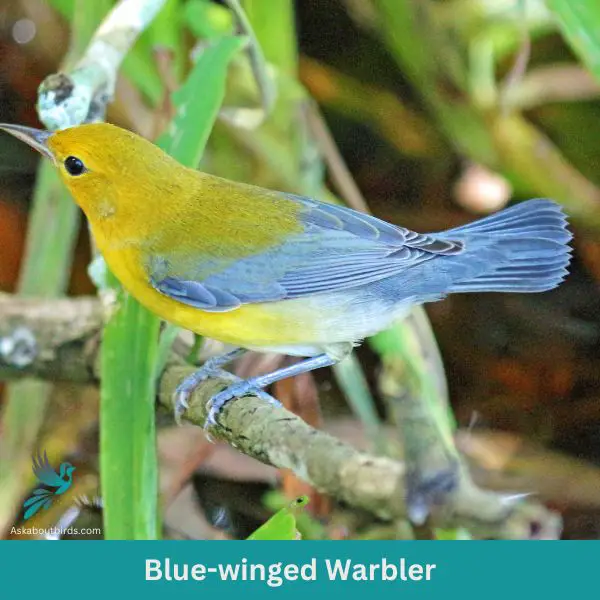
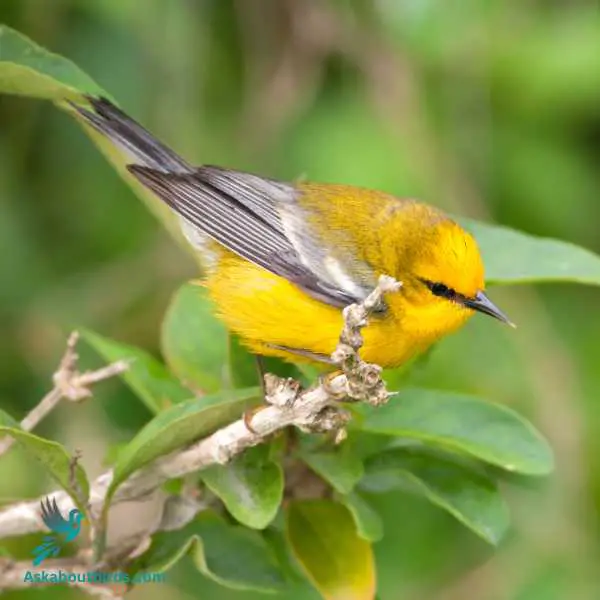
| Trait | Blue-winged Warbler |
|---|---|
| Scientific Name | Vermivora cyanoptera |
| Length | 4.3-4.7 inches |
| Wingspan | 6.7-7.5 inches |
| Weight | 0.3-0.4 ounces |
The Blue-winged Warbler is a vibrant songbird that stands out with its lemon-yellow coloring and buzzing song.
Appearance: This warbler displays a brilliant yellow body contrasted by blue-gray wings and a slim, black line through the eyes. The wings also feature two white wing bars.
Diet: The diet of the Blue-winged Warbler primarily consists of insects and spiders. They actively forage in shrubs and low trees, picking off their prey from the foliage.
Reproduction: Blue-winged Warblers build their nests on or near the ground, using grasses and other fine materials. The female lays a clutch of 4-6 eggs, which she incubates.
Cerulean Warbler
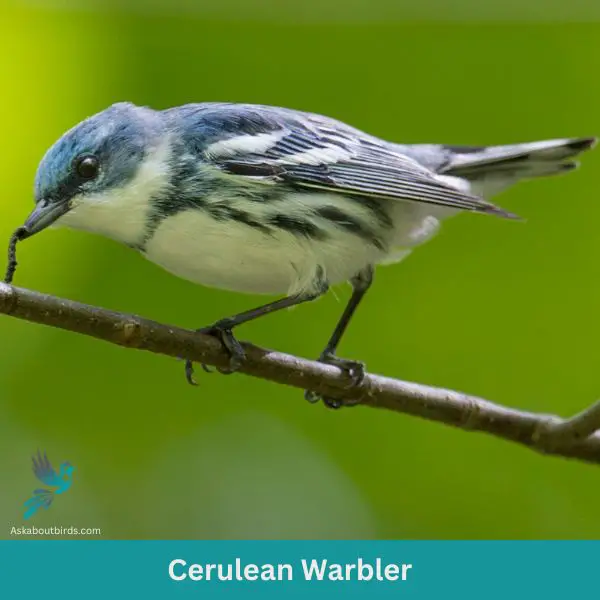
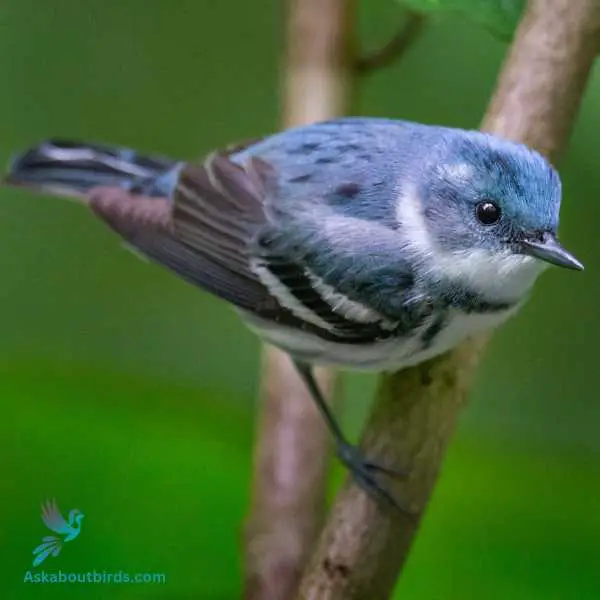
| Trait | Cerulean Warbler |
|---|---|
| Scientific Name | Setophaga cerulea |
| Length | 4.5 inches |
| Wingspan | 7.9-8.7 inches |
| Weight | 0.3-0.4 ounces |
The Cerulean Warbler is a striking songbird known for its sky-blue plumage and flitting movements in the forest canopy.
Appearance: Males boast a vibrant cerulean blue color on their upperparts, with streaked underparts, and a black necklace. Females have a more subdued bluish-green hue and lack the prominent black markings seen in males.
Diet: The diet of the Cerulean Warbler is predominantly made up of insects and spiders. They actively forage high in the treetops, gracefully maneuvering through leaves and branches.
Reproduction: Cerulean Warblers nest in the upper branches of tall deciduous trees. The female weaves a shallow cup-shaped nest and lays a clutch of 3-5 eggs.
Where to Spot West Virginia’s Blue Birds
West Virginia, with its rich variety of habitats, is a haven for birdwatchers and particularly for those with a keen interest in blue birds. Below are some of the top locations in the eastern half of state known for their blue bird diversity:
- Canaan Valley National Wildlife Refuge: This high-altitude valley contains a mix of wetlands, forests, and meadows that attract a variety of bird species, including the Eastern Bluebird and Indigo Bunting.
- New River Gorge National Park and Preserve: Known for its dramatic scenery, the New River Gorge is home to more than 240 bird species, including the Blue Grosbeak and Blue-headed Vireo.
- Monongahela National Forest: This vast forest offers a variety of habitats, from lowland hardwoods to highland spruce-fir forests, attracting a diverse range of bird species including the Cerulean Warbler and Eastern Bluebird.
- Pipestem Resort State Park: Located along the Bluestone River, this park is a great spot for spotting a variety of birds including the Blue-winged Warbler and Blue Jay.
- Ohio River Islands National Wildlife Refuge: Comprising 22 islands and four mainland tracts along 362 miles of the Ohio River, this refuge is home to a wide range of bird species including the Belted Kingfisher and Tree Swallow.
| Neighboring States with Blue Birds | Best Spots for Blue Birds |
|---|---|
| Kentucky’s Blue Birds | 1. Daniel Boone National Forest 2. Mammoth Cave National Park 3. Lake Cumberland State Resort Park |
| Maryland’s Blue Birds | 1. Assateague Island National Seashore 2. Catoctin Mountain Park 3. Blackwater National Wildlife Refuge |
| Ohio’s Blue Birds | 1. Magee Marsh Wildlife Area 2. Cuyahoga Valley National Park 3. Ottawa National Wildlife Refuge |
| Pennsylvania’s Blue Birds | 1. Hawk Mountain Sanctuary 2. Presque Isle State Park 3. Ricketts Glen State Park |
| Virginia’s Blue Birds | 1. Shenandoah National Park 2. Great Dismal Swamp National Wildlife Refuge 3. Chincoteague National Wildlife Refuge |
FAQs on Blue Bird Species Found in West Virginia
How Can I Attract Purple Martins to My Yard?
To attract Purple Martins, first consider installing bird feeders filled with sunflower seeds, which they enjoy. However, Purple Martins are more inclined towards natural water habitats, so including a bird bath can be especially inviting for them. Installing specialized Purple Martin houses in tall trees will further encourage these blue beauties to choose your yard as their residence. Providing scattered trees and open spaces replicates their preferred deciduous forest habitats. If you live near golf courses, you’re in luck—Purple Martins often frequent these areas. The early spring is an excellent time to set everything up, as this is when they typically migrate back to North America.
What Do Black-Throated Blue Warblers Eat?
Black-throated Blue Warblers are primarily insectivorous, but they also consume small fruits and occasionally visit the bird feeder for sunflower seeds. These small birds are distinctive, having bluish-gray plumage with black wings and a white belly. They are usually found in deciduous forests and prefer areas with tall trees. If you wish to attract these wonderful birds, make sure your yard provides an abundance of plant material for them to forage in. Range maps indicate they are often found from Southern New York to West Virginia year-round.
What are the Key Differences Between Red-Breasted and White-Breasted Nuthatches?
The Red-breasted Nuthatch and White-breasted Nuthatch are two distinct species of nuthatches found in North America. The Red-breasted Nuthatch has a distinct rusty brown underparts and a black stripe through the eyes, while the White-breasted Nuthatch has a white face and belly with a black cap on its head. The Red-breasted Nuthatch is generally smaller in size compared to the White-breasted Nuthatch. Both species have a similar diet consisting of seeds, insects, and small mammals, and both can be attracted to bird feeders with sunflower seeds.
Where Can I Find the Indigo Bunting Range Map?
For reliable information on the Indigo Bunting’s range, the Cornell Lab of Ornithology is a trustworthy resource. They provide comprehensive range maps that can offer valuable insights into where these birds can be found during different seasons. This is particularly useful for bird-watchers looking to document or study these captivating creatures. The National Park Service also offers credible information and also has the barn swallow range map and one for the black throated blue warbler. Range maps serve as an excellent guide for identifying the geographical areas where you can find these blue-colored birds.


